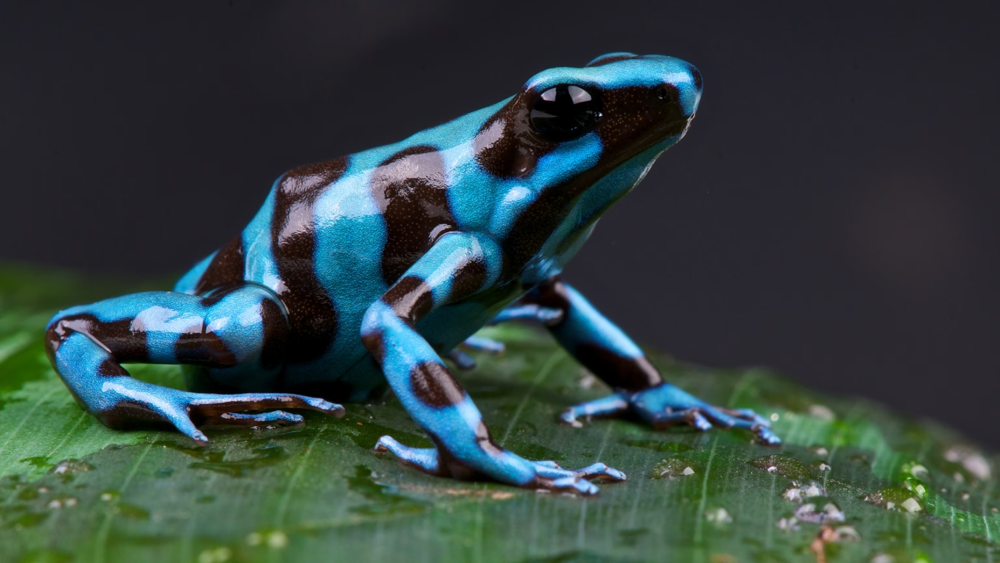Poison dart frog, belonging to the family Dendrobatidae, are a group of small, brightly colored amphibians found primarily in Central and South America. Renowned for their stunning appearance and potent toxins, these frogs have fascinated scientists, indigenous cultures, and nature enthusiasts alike. This article delves into the diverse world of poison dart frogs, exploring their biology, behavior, ecological significance, and the conservation challenges they face.
Taxonomy and Distribution
Poison dart frogs are classified under the family Dendrobatidae, which comprises around 200 species spread across several genera, including Dendrobates, Phyllobates, and Epipedobates. These frogs inhabit a range of tropical environments, from the humid lowland rainforests to the montane cloud forests of countries like Colombia, Ecuador, Brazil, and Costa Rica.
Physical Characteristics
One of the most striking features of poison dart frogs is their vibrant coloration, which can range from brilliant blues, greens, and reds to more subdued yellows and oranges. This aposematic coloration serves as a warning to potential predators about the frog’s toxicity. Their small size, usually between 1.5 to 6 centimeters in length, belies the potency of the toxins they carry.

Toxicity and Defense Mechanisms
The toxins of poison dart frogs are among the most powerful in the animal kingdom. These toxins are alkaloids, which the frogs accumulate through their diet of ants, mites, and other small invertebrates. The most notorious of these toxins is batrachotoxin, found in the genus Phyllobates, which can disrupt nerve impulses and cause paralysis or death.
Indigenous tribes have long utilized these toxins for hunting, coating the tips of blow darts to immobilize prey, hence the name “poison dart frog.” The process involves carefully extracting the toxin by gently heating the frog over a fire, causing it to excrete the poison, which is then applied to the darts.
Behavior and Reproduction
Poison dart frogs are diurnal, meaning they are active during the day. They exhibit a range of interesting behaviors, including complex mating rituals. Males are highly territorial and use vocalizations to attract females and deter rivals. Once a pair mates, the female lays eggs in a moist environment, often on leaves or in small pools of water.
Parental care is a hallmark of many poison dart frog species. Males or females (depending on the species) will often transport newly hatched tadpoles on their backs to water bodies where they can continue their development. Some species, like the Oophaga pumilio, engage in extended parental care, with females feeding their tadpoles unfertilized eggs until they metamorphose into frogs.
Ecological Role
Poison dart frogs play a crucial role in their ecosystems. As both predator and prey, they help maintain the balance of their food web. By consuming large quantities of ants and other small insects, they control the population of these species, which can otherwise become pests.
Moreover, their toxins have sparked significant interest in medical research. Scientists study these compounds for their potential to develop new painkillers and heart medications, demonstrating the frogs’ importance beyond their immediate ecological niche.
Conservation Status and Threats
Despite their resilience and adaptability, poison dart frogs face numerous threats. Habitat loss due to deforestation, agriculture, and urban development is the most significant threat, leading to the fragmentation and destruction of their natural habitats. Climate change also poses a risk, as alterations in temperature and precipitation patterns can affect the delicate balance of their ecosystems.
Another pressing concern is the pet trade. The allure of their vivid colors and exotic nature makes poison dart frogs a target for illegal collection and trade. While some countries regulate the trade of these amphibians, illegal smuggling continues to endanger wild populations.
Additionally, the spread of the chytrid fungus (Batrachochytrium dendrobatidis) has devastated amphibian populations worldwide, including poison dart frogs. This fungal infection disrupts the skin’s ability to regulate water and electrolytes, often leading to death.
Conservation Efforts
Efforts to conserve poison dart frogs are multifaceted, involving habitat protection, legal regulations, captive breeding programs, and public education. Numerous organizations and governments are working to establish protected areas and restore degraded habitats, ensuring that these frogs have a safe environment to thrive.
Captive breeding programs in zoos and research institutions aim to create stable populations of poison dart frogs that can be reintroduced into the wild if necessary. These programs also serve as a genetic reservoir, preserving the biodiversity of the species.
Public education campaigns are essential to raising awareness about the plight of poison dart frogs. By educating local communities and the broader public about the importance of these frogs and the threats they face, conservationists hope to foster a sense of stewardship and encourage sustainable practices.
Conclusion
Poison dart frog is a remarkable example of nature’s ingenuity and beauty. Their vibrant colors, potent toxins, and intricate behaviors make them a subject of fascination and study. However, the survival of these amphibians hinges on our ability to protect their habitats and mitigate the threats they face. Through concerted conservation efforts and a deeper appreciation of their ecological value, we can ensure that these extraordinary creatures continue to thrive in the wild for generations to come.









